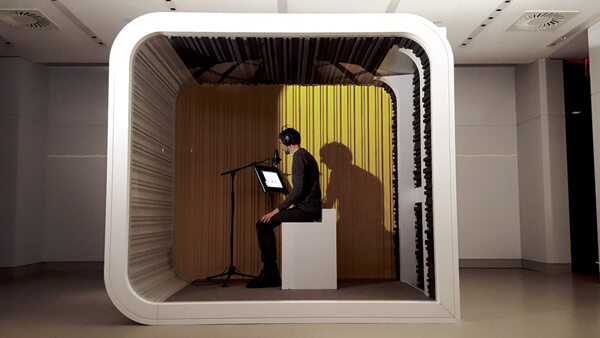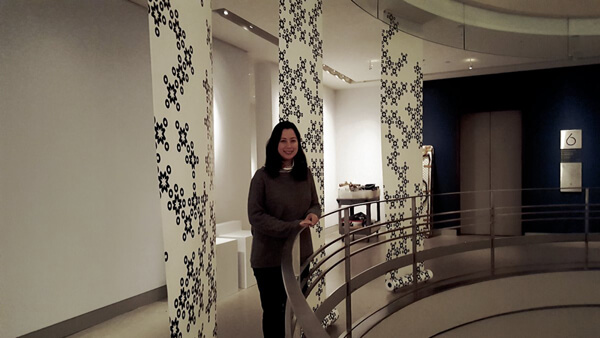By Dusica Sue Malesevic
If recent presidential executive orders are causing hyperventilation, Manhattan’s Rubin Museum of Art — which celebrates the art and culture of the Himalayas and neighboring regions — is offering a way to slow down, take a deep breath, and say “Om.”
“It’s a very important concept for our time right now,” Risha Lee, the curator, said at a sneak peek of the museum’s newly installed “OM Lab.”
Starting this Friday, the temporary participatory space will invite visitors to the sixth floor, which has been turned into a sleek, sparse area dominated by a white booth in which participants can have a go at the enduring Sanskrit mantra.
“The process is a bit tricky,” Terence Caulkins, sound and interaction designer for the exhibition, said. “We’re trying to make it as easy as possible for people to produce their most authentic Om.”
Caulkins, who designed the iPad interface visitors will be using, said in a phone interview that the program will “guide people through the process of doing the recording.”
First, a visitor will prepare — sit upright, put on the headphones and get close to the microphone. Next, they will hear three samples of Tibetan monks chanting at lower, medium and higher pitches, and will hum along to see which pitch they should record at, Caulkins explained. After choosing their pitch, the visitor will then record their Om. While the chant is being recorded, a waveform is projected on wall behind the booth.
Banners in front of the booth will provide information about Om, which Lee said in a phone interview “has a huge 3,000 years of history that is absolutely fascinating, and might not be known to the wider public. We wanted to involve the community. Om by its nature is communal.”
“Om can be considered to be the most supreme mantra — it condenses all of the meaning into one word, so to speak,” Jorrit Britschgi, director of exhibitions, collections and research at the Rubin, said in a phone interview. “Om cannot be reduced to smaller parts. It’s the smallest possible molecule, sonically speaking.”
The OM Lab grew out of brainstorming and planning for a larger exhibition, called “The World Is Sound,” which will open in June, Lee explained. “The World Is Sound” is “so interesting, that it spilled over. We realized this [OM Lab] could be an exhibition itself,” she said.
Britschgi said that the whole point of OM Lab is to be an interactive and participatory experience for visitors. After the chants are recorded, they will be woven together and some will become part of “The World Is Sound” exhibition.
This will be the first time that visitors participating in one exhibition will be featured in another, according to Robin Carol, who handles public relations for the Rubin.
After an initial culling of the chants, Caulkins will knit them together, with the hope “that it will create this interesting blending of voices,” he said. The installation featuring the Oms will be dynamic, shifting between different tones and chants, with visitors awash in a “sound bath” as peakers will be placed around the room to create a “3D sound field,” Caulkins said.
Britschgi said the OM Lab is a way to connect with Himalayan art, and that “Om is deeply rooted to the traditions that the Rubin stands for.”
Carol said the museum does outreach to the Himalayan community — a hub of which is in Jackson Heights — with their monthly Himalayan Heritage Meetup, their Family Sundays program, and the museum’s block party.
The lab will deepen people’s experience and understanding of Om, Lee said.
“The exhibition is connecting people with something they’ve already known and heard to something that’s greater,” he said. “That was important — to plant the seed that things in the Rubin already exist in the outside world.”
The Rubin’s “The World Is Sound” exhibition, Lee added, will expand the museum’s scope beyond the focus of objects.
In addition to the lab, the museum is also hosting an “OM-In” on Feb. 24–25, which will feature a series of events — including adult coloring, sound mediation, lectures, performances, and yoga.
The OM Lab will be at the Rubin Museum of Art (150 W. 17th St., btw. Sixth & Seventh Aves.) from Feb. 3 through May 8. For more info, visit www.rubin





































